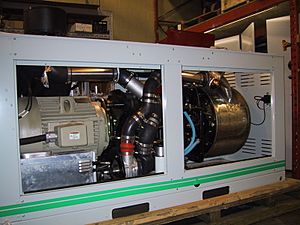Bioenergy facts for kids

Bioenergy is a type of renewable energy that comes from living things or their waste. Think of it as energy made from plants, animals, and their leftovers! Sometimes, people use "bioenergy" and "biofuel" to mean the same thing. Biofuel is simply fuel made from biological sources.
But in a bigger sense, bioenergy also includes biomass. Biomass is the actual biological material, like wood or plants, that we use to create energy. So, biomass is the fuel, and bioenergy is the energy we get from that fuel.
Biomass is any natural material that has stored energy from the sun. It's like plants capturing sunlight and turning it into chemical energy. When we use biomass as fuel, it can be things like wood, wood scraps, straw, manure, or even Sugarcane. Many other leftover materials from farming can also be used.
In Europe, people often say "bioenergy," while in North America, "biofuel" is more common.
What is Solid Biomass?
Biomass is material that comes from living things that have recently died. This includes plants, animals, and their waste products. For example, manure, garden waste, and leftover parts of crops are all sources of biomass.
Biomass is a renewable energy source. This means it can be replaced naturally over time, unlike petroleum (oil), coal, or nuclear fuels, which are limited. Biomass is part of the carbon cycle, where carbon moves between living things and the atmosphere.
Farmers can also grow special crops just for making biofuel. Some of these crops include corn and switchgrass in the United States. In Europe, rapeseed, wheat, and sugar beet are grown. Sugarcane is important in Brazil, and palm oil is used in Southeast Asia. Other crops like sorghum, cassava, and jatropha are grown in places like China and India. Even Hemp can be used to make biofuel!
Waste from industry, agriculture, forestry, and homes can also be turned into biofuel. For example, we can use anaerobic digestion to make biogas (a type of gas fuel). Or, we can use gasification to create syngas. We can also just burn these materials directly.
Examples of useful biodegradable waste include straw, wood, manure, rice husks, and food waste. Using biomass fuels helps manage waste and can make sure we have enough energy. It can also help reduce climate change, though it's not the only solution.
Images for kids
See also
 In Spanish: Bioenergía para niños
In Spanish: Bioenergía para niños
















